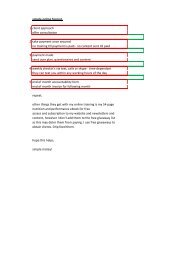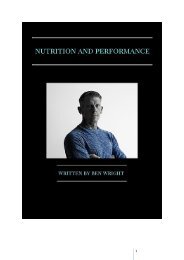Create successful ePaper yourself
Turn your PDF publications into a flip-book with our unique Google optimized e-Paper software.
You can also get various other non-dairy whey products like:<br />
<br />
<br />
<br />
<br />
<br />
<br />
<br />
Pea protein<br />
Rice protein<br />
Ric & pea protein combined (excellent amino profile, recommended)<br />
Soya protein (careful if you male as it contains higher levels of oestrogen)<br />
Hemp<br />
Egg white (recommended)<br />
Faba bean protein<br />
Please remember though, that whey is a byproduct of milk. So, if you have issues with dairy then<br />
make sure that you are very careful when buying whey protein. I would personally opt for a raw<br />
vegan whey instead. However wholefoods should always come first <strong>and</strong> foremost as they will<br />
always provide the best results.<br />
Creatine - Creatine is made up of three different amino acids; glycine, arginine <strong>and</strong> methionine.<br />
Nothing fancy… that’s it! 95 percent of natural forming Creatine is found in the skeletal muscle<br />
tissue. Creatine is made naturally in the body <strong>and</strong> it starts to get used when intensity levels during<br />
training require it to. Put simply the body is full of energy. When we train, we use up that energy in<br />
the form of ATP cells. What’s left is ADP. When we take Creatine we simply turn the ADP back into<br />
ATP (energy) <strong>and</strong> we can train harder.<br />
How I describe this to my clients is simple. Imagine you are a smart phone. You have been on idle all<br />
night long, <strong>and</strong> when you wake up you are about 60 percent energised. Creatine would be like<br />
putting the charger into the wall <strong>and</strong> bumping up the energy level. So, when you go training <strong>and</strong><br />
you’re lifting weights for example, when you get to the point of failure the Creatine will kick in <strong>and</strong><br />
that extra boost from the energy supply you gave yourself will suddenly kick in <strong>and</strong> help you push<br />
through more reps. Simple.<br />
Do I feel Creatine use during training is worthwhile? Definitely.<br />
BCAA’s: Branched chain amino acids are another supplement commonly used. It will come in h<strong>and</strong>y<br />
if you’re training fasted (fasted being when your food is digested, not just in the mornings contrary<br />
to popular belief). However, if you have already eaten before training, specifically some protein then<br />
this product becomes pointless. This is since BCAA’s are simply three amino acids.<br />
<br />
<br />
<br />
Leucine: Helps in the ability to stimulate protein synthesis. Build muscle. The most important<br />
of the three<br />
Isoleucine: the second most important of the three. This also helps in the recovery of muscle<br />
tissue. Also, it helps to increase glucose <strong>and</strong> the usage of glucose during training.<br />
Valine: This doesn’t have any major significance when compared to the other two.<br />
So, if you eat protein in <strong>and</strong> around training <strong>and</strong> if you have a healthy diet supported by protein then<br />
the need to take a load of BCAA’s into your system seems pointless <strong>and</strong> expensive. However, if you<br />
decide to train in a fasted state (when food is completely digested) then a BCAA product can help.<br />
Casein: Like whey but it has a longer lasting effect that isn’t as fast acting as normal whey protein. I<br />
would generally advise to use a product like casein during the day as a snack or before bed. It can<br />
help to top up protein levels, but then so can food….<br />
34




